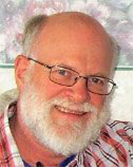Northern Forest Wetlands: Characteristics and Influences on Invertebrates and Amphibian Community Structure

Fred J. Ossman has completed his MS thesis and continues on with his Ph. D research in the Department of Biological Sciences at NDSU.
Fellow: Fred J. Ossman, Department of Biological Sciences, NDSU
Advisor: Malcolm Butler, Professor of Biological Sciences, NDSU
Matching Support:Minnesota Department of Natural Resources, St. Paul, MN.
Degree Progress: M.S. completed in December 2002, continues for a Ph. D degree at NDSU
Northern Forest Wetlands: Characteristics and Influences on Invertebrates and Amphibian Community Structure
Community structure in seasonal wetlands may be subject more to physical features than to biotic influences. Because forest wetlands are functionally linked to the adjacent upland forest, physical modifications to the uplands may alter annual development of community structure. Timber harvesting modifies vegetation and local patterns of hydrology, including hydroperiod; thus it is likely that biotic communities and physical features of adjacent wetlands are influenced.
Fred characterized physical features and biotic communities of northern forest wetland sites, and assessed relationships among wetland communities and forest age structure in adjacent uplands. He sampled macroinvertebrates and recorded physical measurements in 24 seasonally flooded wetlands, within aspen-dominated landscapes, throughout the growing season (figure 1). Sampling was conducted three times per field season, initiating upon ice-out on these wetlands. Data were described using a combination of statistical techniques including multivariate Redundancy analysis (RDA), Principal Components Analysis (PCA), and mixed-model ANOVA.
Fred used partial-RDA to test for effects from physical attributes with the invertebrate community as his response variable. He used both sample period (time) and forest location , as covariables in the model. These two variables, and their associated variances, were accounted for, and removed from the model. Partial-RDA indicated that invertebrate community structure was influenced by upland forest age-structure, forest location, amount of canopy, initial water depth, hydroperiod, total alkalinity, and the presence of predatory invertebrates. A variance partioning exercise was conducted on the environmental variables to determine what portion of the total variance from the partial-RDA was attributable to each variable. It is shown that sampling period and forest location were found to have the highest proportion of the variance (hence were removed from the p-RDA), with variances for canopy, hydroperiod, forest-age, initial water depth, pH, and total alkalinity were also determined.
Additionally, Fred assessed fixed-effects of forest-age structure and location (state forests) using a repeated measures, mixed-model analysis of variance (ANOVA) on the PCA site scores. He used the invertebrate data (represented here as site scores) as the response variable; all tests were conducted at the alpha = 0.10 level. All mixed-model procedures were performed using the MIXED Procedure in SAS. Mixed-model ANOVA showed a significant (p< 0.05) spatial (location) and structural (age-class) interaction among wetland sites.
Time of sampling, forest-age structure, pH, specific conductance, soil temperature, and especially hydroperiod and amount of forest canopy-closure are important influences of invertebrate community structure. Thus alterations to these physical components would likely induce a subsequent changes in the invertebrate communities inhabiting wetlands adjacent to forested areas. This characterization of the macroinvertebrate communities and their analyses in light of the physical properties of his study sites completes Phase I of this study.
Phase II is currently underway with data for the fourth year still being sorted and analyzed. Data from this portion of the study tends to support that clear-cutting activities increase hydroperiod in those wetlands adjacent to the clear-cut. Trends also suggest that water depth in the spring increases in association with the clear-cut areas. This result is surprising given that the past two winters in northern Minnesota experienced below average snowfall amounts. Taken together, increased depth and hydroperiod, may result in a change in the legal definition of which classification these wetlands fall under. However, if those physical changes are indeed taking place, it may be a short term effect. Water depth and hydroperiod may return to there normal levels and periodicity as the forest regenerates.
Macroinvertebrate communities in the clear-cut wetlands (post treatment) also appear to be more heavily influenced by predatory invertebrates than those communities found in pre-treatment conditions. Biological controls of the communities are more typical in lakes and more wetlands of longer duration. Increasing hydroperiods in temporary wetlands may remove ephemeral species from specific wetlands. Ephemeral organisms, such as Anostracans, have no defense from predators. Invertebrates, especially those that are predaceous that normally invade these wetlands in the spring may become established and displace or dominate the wetlands community. Changing food-chain-base structure may also displace organisms that rely upon these wetlands as a food source.
A copy Fred's thesis can be obtained from Prof. M.G. Butler.
Relevant Publications of K.D. Zimmer and the Butler Research Group
December 2000, 62nd Midwest Fish and Wildlife Conference Minneapolis, Mn., “Aquatic Invertebrates in Seasonal Forest Wetlands: Characteristics and Influences”
June 2001, North American Benthological Society 49th Annual Meeting. LaCrosse, WI., “Invertebrate Communities in Northern Forest Wetlands: Characteristics and Controls”.

Melcolm Butler
Biological Sciences
Office: Research 2, Room 214B
Phone: 701-231-7398
Email: malcolm.butler@ndsu.edu


